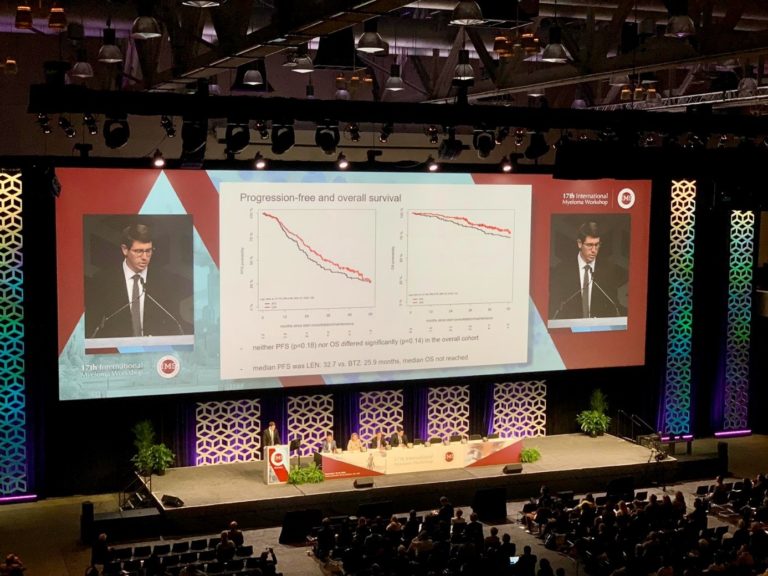Lenalidomide versus bortezomib maintenance after frontline autologous stem cell transplantation for multiple myeloma.
Baertsch MA*, Mai EK*, Hielscher T, Bertsch U, Salwender HJ, Munder M, Fuhrmann S, Dührsen U, Brossart P, Neben K, Schlenzka J, Kunz C, Raab MS, Hillengaß J, Jauch A, Seckinger A, Hose D, Luntz S, Sonneveld P, Lokhorst H, Martin H, Goerner M, Hoffmann M, Lindemann HW, Bernhard H, Blau IW, Scheid C, Besemer B, Weisel KC, Hänel M, Dürig J, Goldschmidt H; German-Speaking Myeloma Multicenter Group (GMMG).
(*contributed equally to this work)
Blood Cancer J. 2021 Jan 7;11(1):1. doi: 10.1038/s41408-020-00390-3. PMID: 33414374.
Abstract:
Lenalidomide (LEN) maintenance (MT) post autologous stem cell transplantation (ASCT) is standard of care in newly diagnosed multiple myeloma (MM) but has not been compared to other agents in clinical trials. We retrospectively compared bortezomib (BTZ; n = 138) or LEN (n = 183) MT from two subsequent GMMG phase III trials. All patients received three cycles of BTZ-based triplet induction and post-ASCT MT. BTZ MT (1.3 mg/m2 i.v.) was administered every 2 weeks for 2 years. LEN MT included two consolidation cycles (25 mg p.o., days 1-21 of 28 day cycles) followed by 10-15 mg/day for 2 years. The BTZ cohort more frequently received tandem ASCT (91% vs. 33%) due to different tandem ASCT strategies. In the LEN and BTZ cohort, 43% and 46% of patients completed 2 years of MT as intended (p = 0.57). Progression-free survival (PFS; HR = 0.83, p = 0.18) and overall survival (OS; HR = 0.70, p = 0.15) did not differ significantly with LEN vs. BTZ MT. Patients with <nCR after first ASCT were assigned tandem ASCT in both trials. In patients with <nCR and tandem ASCT (LEN: n = 54 vs. BTZ: n = 84), LEN MT significantly improved PFS (HR = 0.61, p = 0.04) but not OS (HR = 0.46, p = 0.09). In conclusion, the significant PFS benefit after eliminating the impact of different tandem ASCT rates supports the current standard of LEN MT after ASCT.
Kommentar:
Die vorliegende Arbeit zur Erhaltungstherapie nach autologer Blutstammzelltransplantation (ASCT) beim neudiagnostizierten Multiplen Myelom (MM) vergleicht den aktuellen Standard, Lenalidomid, gegen den Erstgenerations-Proteasominhibitor Bortezomib. Hierbei wurden zwei aufeinanderfolgende Phase III Studiengenerationen der GMMG, HD4 und MM5 (Leiter der klinischen Prüfungen: Prof. Dr. Hartmut Goldschmidt) verglichen. In diese beiden GMMG Studien wurden insgesamt 1003 Patienten eingeschlossen. Es handelt sich um die erste Auswertung, die eine vergleichende Analyse ohne spezifische Patientenselektion (z.B. nach zytogenetischen Aberrationen) und basierend auf detaillierten Studiendaten durchführt. Hierbei konnten die Erstautoren Dres. Marc-Andrea Baertsch und Elias K. Mai (beide Ärzte in der Inneren Medizin V am Universitätsklinikum Heidelberg) in enger Kooperation mit der Biostatistik des Deutschen Krebsforschungszentrum Heidelberg (Thomas Hielscher und Dr. Christina Kunz) herausarbeiten, dass Lenalidomid grundsätzlich für alle Patientengruppen, auch mit ungünstiger Zytogenetik, wirksam ist. Bortezomib stellt eine gute Alternative dar, welche jedoch ähnlich dem Zweitgenerations-Proteasominhibitor Ixazomib, nicht von der EMA zugelassen ist, jedoch in Einzelfällen (z.B. Unverträglichkeit von Lenalidomid) bei den Krankenkassen beantragt werden kann. In naher Zukunft werden erste Phase III Daten zur Kombination von Lenalidomid mit monoklonalen Antikörpern (z.B. Daratumumab) erwartet, welche womöglich einen neuen Standard etablieren.
Die vorliegende Arbeit wurde zudem 2019 auf dem International Myeloma Working Group (IMWG) Meeting in Boston (USA) im Plenariumssaal von Dr. Elias K. Mai vorgestellt (siehe Foto).
